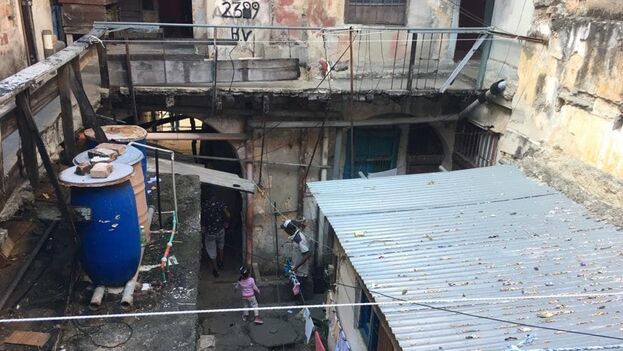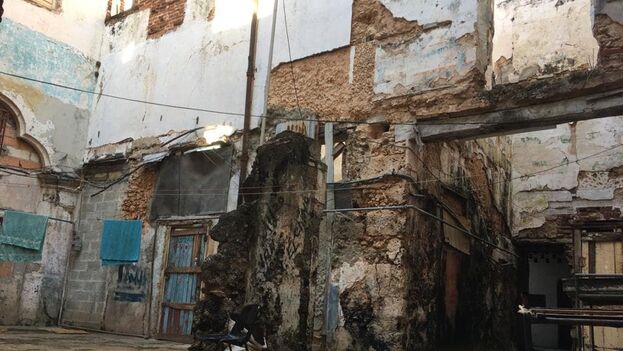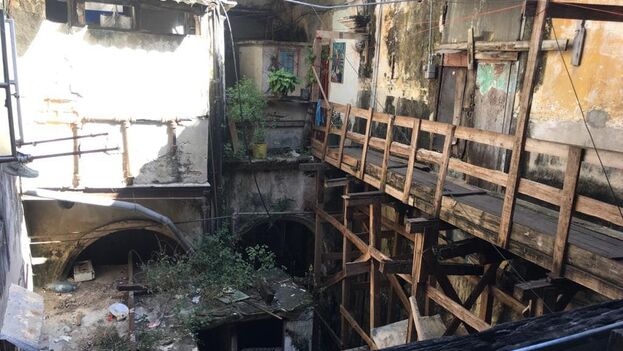
![]() 14ymedio, Eustaquio García, Havana, 16 January 2021 — Residents on Cuarteles Street, located in Old Havana, do not know what it means to have a decent home. The so-called ciudadelas [tenements] located on this road, one of the oldest in the capital, suffer continuous collapses, but its inhabitants have never been able to leave some of the buildings that have been considered uninhabitable for decades.
14ymedio, Eustaquio García, Havana, 16 January 2021 — Residents on Cuarteles Street, located in Old Havana, do not know what it means to have a decent home. The so-called ciudadelas [tenements] located on this road, one of the oldest in the capital, suffer continuous collapses, but its inhabitants have never been able to leave some of the buildings that have been considered uninhabitable for decades.
“I’ve lived here for 35 years and, although there have been more than ten collapses, and our apartments are damp, and we have a shelter order, we have never been able to leave this place,” Damaris Luna tells 14ymedio; Luna lives on the street at Number 4, between Cuba and Aguiar, where 22 families live in a similar situation.
The precarious situation of their home even affects their income, explains Damaris, a manicurist by profession, who claims to have lost many clients. When they look at the entrance to the tenement, they lose the desire to enter. And even more so to climb the stairs.
“All the authorities know it, but they do nothing. They have promised on more than one occasion to get us out of here and give us a home but that never happens. The last promise was at the end of 2018 and we are still waiting,” she laments.
The most recent collapse of this building occurred on September 19, 2020, when a wall collapsed and disabled the shared bathroom, used by five families, for several days.

Neighbors recall, however, how diligent action was taken in a 1988 collapse on this site. The apartment belonged to the famous national baseball player Lázaro Valle. “They took him out and gave him a better house, but we’re still here, we don’t even have our own bathroom. Our houses are propped up inside, and so are the stairs and hallways. Whoever enters this building seems to have reached the stage of a film from the 19th or 18th century,” says María Vega, a woman in her 70s who has lived at Number 4 all her life, with regret and a slight smile.
On the street, just three blocks long and located very close to the bay, some tenements are more than 400 years old and are completely in ruins. This is also the case of Numbers 7 and 11, which in a competition against time and abandonment have an extremely gloomy aspect.

“This lot has had a shelter order since 1961, but the houses that are supposedly supposed to go to us are always given to other people. The little that we have been able to fix, such as the roof of our rooms and the railing of the second level, has always been by my own effort,” complains Mariela Santiesteban, a resident of Number 11.
“There are 28 rooms here and they all get wet or have a lot of dampness. They have never even given us a sack of cement or sand to fix it, only once did they put some very bad tiles that immediately deteriorated again due to their poor quality. Because of this we are still in the same situation: total helplessness,” adds the 53-year-old woman.
José Antonio Moreno, one of her neighbors, would be satisfied with any alternative. “I can even use an apartment in Siberia to get out of here!” He says between a smile and resignation. At 60, he adds, he can barely clean the floor in his room. “It leaks on the neighbors downstairs and it’s in very bad shape. One time my roof was ripped completely off with a cyclone and I had to repair it myself, but here we are in constant danger.”
In the lot of Number 7 there are only the small rooms located on the ground floor. All of the upper floors have collapsed in recent decades, and its residents are not even in the mood to speak.
Three years ago the Government recognized a deficit of almost one million homes on the Island, a very serious situation that it aspired to alleviate in a period of ten years, but the shortage of materials due to a persistent crisis affects a problem that continues to leave millions of families in suspense, not knowing when they might see their roof coming down.
According to a report from the Cuban Observatory for Human Rights, from last October, almost half of the homes in the country need repair, and 11% of families live in places at risk of collapse.
____________
COLLABORATE WITH OUR WORK: The 14ymedio team is committed to practicing serious journalism that reflects Cuba’s reality in all its depth. Thank you for joining us on this long journey. We invite you to continue supporting us by becoming a member of 14ymedio now. Together we can continue transforming journalism in Cuba.
